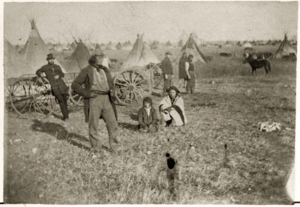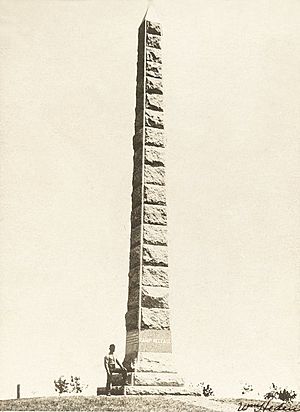Surrender at Camp Release facts for kids
The Surrender at Camp Release was the final event of the Dakota War of 1862. After the Battle of Wood Lake, Colonel Henry Hastings Sibley decided not to chase the retreating Sioux. He knew he didn't have enough supplies for a long chase. Also, he heard that Chief Little Crow was losing support. Sibley had even been talking with some Mdewakanton chiefs who wanted the fighting to stop.
On September 26, 1862, Colonel Sibley arrived at Camp Release. There, a group of Dakota people who wanted peace handed over 269 captives. These captives had been held by the group that was still fighting. After this, Little Crow and his followers left. In the days that followed, more Mdewakanton warriors who had fought quietly joined the "friendly" Dakota at Camp Release. Many were convinced by Sibley's promise to only hold responsible those who had harmed people.
Even after this "surrender," many Dakota warriors who had been fighting were still free. More conflict broke out the next year and continued until 1865. Sadly, many Dakota people who had surrendered at Camp Release were later sent away from Minnesota in 1863.
Rescuing Captives at Camp Release
On September 23, 1862, during the Battle of Wood Lake, Gabriel Renville and Solomon Two Stars, along with other "friendly" soldiers, hid in a ravine. They did this to avoid fighting Sibley's troops. Some of these "friendly" soldiers went into Little Crow's camp to rescue white and mixed-blood captives. They used force if needed and brought them back to their own camp for safety. To protect them from those still fighting, they hid the captives in large pits dug inside their lodges. Around the same time, Renville and Solomon Tukanshaciye chased a group fleeing west. They managed to free even more captives.
After the Battle of Wood Lake, things became very chaotic in both camps. A few Mdewakanton soldiers who had been fighting wanted to attack the friendly camp. Little Crow refused. He argued that it would cause more deaths and start a civil war among his own people. He told his followers to pack up and leave instead. As he got ready to go to the northern Great Plains, he asked to see Antoine Joseph Campbell. Campbell was a mixed-blood interpreter who had worked at the Redwood Agency. He had joined Little Crow in battle and helped him write letters to Sibley. Campbell returned from Sibley's camp with a final message. Sibley demanded that Little Crow surrender completely. Little Crow greeted Campbell warmly as "cousin." He laughed at Sibley's message but agreed to make his soldiers give the remaining 46 captives in his camp to Campbell.
In the days that followed, chiefs from the Sisseton and Wahpeton tribes, like Red Iron (Mazaduta) and Standing Buffalo, sent messages. Leaders of the "friendly" soldiers, such as Gabriel Renville, also sent messages. Mdewakanton chiefs like Wabasha and Taopi, who had joined them, sent Antoine J. Campbell to Sibley. They wanted Sibley to know the captives were safe. They also wanted Sibley to promise that Dakota people who had not harmed anyone would not be hurt. In his letters, Sibley promised, "I have not come to make war upon those who are innocent but upon the guilty." He told the friendly groups to stay in their camps and fly a white flag.
Sibley's Troops Arrive at Camp Release
On September 25, 1862, Colonel Sibley's troops left Lone Tree Lake. They marched slowly and carefully about ten miles to the Hazelwood mission, near Granite Falls, Minnesota. The next morning, September 26, Sibley and a small group of American soldiers entered the "friendly" camp. This camp became known as Camp Release. Sibley saw "nothing but white rags, attached to the top of tepee poles," which were signs of peace.
Sibley wrote about the event. He said, "The Indians and half-breeds assembled... in considerable numbers." He then told them his thoughts about the recent events. He stated his plan to find and capture those who were responsible for the fighting. He also demanded that all the captives be given to him right away.
In his memories, Gabriel Renville said, "With joyous handshaking we met, and the white prisoners were taken into the soldiers' camp." Major Joseph R. Brown was finally reunited with his wife, Susan Frenier Brown, and their children.
The Dakota Peace Party immediately released 91 white settlers and about 150 mixed-blood captives. Within the next few days, they secured the release of even more captives. The total number of captives was 107 white people and 162 mixed-blood people, making a grand total of 269.
In the nights that followed, more Mdewakanton people quietly joined the families at Camp Release. Some of them had been with Little Crow's group and did not want to flee to the plains. Sibley allowed them to come in. He only asked that they give up their guns and ammunition. Historian Gary Clayton Anderson writes that Sibley intended to capture as many of these Native Americans as possible. He believed most of them were involved in harming civilians.
On September 28, 1862, a military group started by Colonel Sibley began to investigate the Dakota men. They wanted to find out who had been involved in the fighting. Several weeks later, these investigations moved to the last building still standing at the Lower Sioux Agency.
Remembering Camp Release
Camp Release Township, Lac qui Parle County, Minnesota was created in 1871. It was named to remember this important event. The Camp Release State Monument near Montevideo, Minnesota was built in 1894. It serves as a memorial to the surrender and release of captives.



